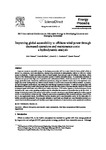Improving global accessibility to offshore wind power through decreased operations and maintenance costs: a hydrodynamic analysis
| dc.contributor.author | Edesess, AJ | |
| dc.contributor.author | Kelliher, D | |
| dc.contributor.author | Borthwick, Alistair | |
| dc.contributor.author | Thomas, G | |
| dc.date.accessioned | 2021-08-22T18:11:47Z | |
| dc.date.available | 2021-08-22T18:11:47Z | |
| dc.date.issued | 2017-10 | |
| dc.identifier.issn | 1876-6102 | |
| dc.identifier.uri | http://hdl.handle.net/10026.1/17724 | |
| dc.description.abstract |
Improved access to renewable energy in developing economies will be a major factor in future global efforts to reduce CO2 emissions, while simultaneously raising living conditions in areas presently without or with only limited access to electricity. Coastal populations stand to benefit greatly from reduced costs of offshore wind farms, which are one of the fastest growing and most economical sources of marine renewable energy. A considerable drawback of offshore wind power is the high cost of operations and maintenance (O&M), which can account for 25-50% of total energy production costs. Present-day maintenance procedures, using crew transfer vessels, rely on the significant wave height (HS) as the limiting factor by which to decide whether or not it is safe to access the offshore turbines. In practice, HS has to be applied conservatively, thus raising the costs through increased downtime. A method is proposed here with the objective of reducing overall costs through improved analysis of the motion of the crew transfer vessels (CTVs) used to transport repair technicians onto offshore wind turbine structures. CTV motion depends on the hydrodynamic forces incident on the vessel under operating conditions and the effect that the presence of the turbine has on the flow field. A change in the hydrodynamic field caused by the turbine monopile can cause a vessel abutted against the turbine support column to lose frictional contact and slip. Using the open-source computational fluid dynamics software, OpenFOAM, and in situ experimental results, the diffracted surface elevation and a wave kinematics model for the near-wake of a turbine monopile are presented. More accurate estimates of significant wave height and wave kinematics incident on a vessel close to a turbine monopile will facilitate much improved analysis of vessel motions under operational conditions. | |
| dc.format.extent | 1055-1060 | |
| dc.language.iso | en | |
| dc.publisher | Elsevier BV | |
| dc.subject | 7 Affordable and Clean Energy | |
| dc.subject | 13 Climate Action | |
| dc.title | Improving global accessibility to offshore wind power through decreased operations and maintenance costs: a hydrodynamic analysis | |
| dc.type | conference | |
| dc.type | Conference Proceeding | |
| plymouth.volume | 138 | |
| plymouth.publication-status | Published | |
| plymouth.journal | Energy Procedia | |
| dc.identifier.doi | 10.1016/j.egypro.2017.10.107 | |
| plymouth.organisational-group | /Plymouth | |
| plymouth.organisational-group | /Plymouth/Faculty of Science and Engineering | |
| plymouth.organisational-group | /Plymouth/Faculty of Science and Engineering/School of Engineering, Computing and Mathematics | |
| plymouth.organisational-group | /Plymouth/Users by role | |
| plymouth.organisational-group | /Plymouth/Users by role/Academics | |
| dc.rights.embargoperiod | Not known | |
| rioxxterms.versionofrecord | 10.1016/j.egypro.2017.10.107 | |
| rioxxterms.licenseref.uri | http://www.rioxx.net/licenses/all-rights-reserved | |
| rioxxterms.type | Conference Paper/Proceeding/Abstract |


